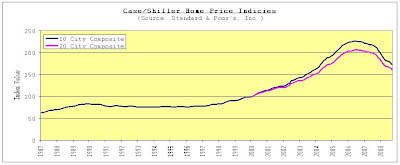As I have mentioned before, debt plays an important role in a capitalist society. The lag between production and sale is managed effectively by debt issuance. In addition, exogenous lags (weather delaying shipments, holidays/seasonal adjustments, etc.) in distribution are mitigated.
Debt does need to be paid back at some point. Interest is charged as well, the amount of which depends on the length of the loan, collateral and the perceived ability of the borrower to pay back the principal in the first place.
In looking at the debt of the U.S. Government, there seems to be no intention of ever paying back the "money" it owes.
The debt of the General Fund is closing in on $11 trillion dollars. This figure includes debt held by other government entities (Social Security trust funds hold about $2.3 trillion). The debt has doubled in the last 10 years and has grown at an annualized rate of 9.3% since 1974. In that time span, the debt outstanding increased every year.
In 1974, the debt could be measured at 33.2% of nominal GDP. This year, it hit 69.5% of GDP. GDP is a proxy of the potential tax pool for the government. Since 1974, government revenue has averaged 18.3% of GDP. This figure has been quite stable, ranging from 16.3% to 20.9%. So, debt outstanding has been growing relative to GDP, while revenue based on GDP has
flatlined.
In 1974, for each additional dollar of debt outstanding, $4.52 of GDP was created. In 2008, a dollar of debt got us 46 cents of additional GDP.
This year, the Treasury agreed to strengthen the guarantee that Fannie Mae and Freddie Mac operated under. Although not an explicit guarantee, the Treasury acknowledged the importance of the orderly operation of the mortgage market and concluded that it was in the best interest of the economy to facilitate trading in these securities. The potential exposure to the government is $6.7 trillion.
The FDIC resembles a drunk trying to stand on one foot while buying a hot dog at the Papaya King window in the rain. I reviewed their position in 2 posts last week.
The TARP will require increased debt issuance as well. In addition, Congress is discussing another stimulus bill on the order of $500 - $700 billion.
On November 3, the Treasury announced that debt issuance would total $550 billion in the 4
th quarter of 2008. DC has outdone itself, doubling the previous record (1st quarter of 2008). The only ray of sunshine is that nominal borrowing rates are quite low, good news for debt service. By the way, the interest on the debt accounts for 17% of the annual budget. Another way to look at it: 39% of individual income taxes go to paying the interest expense of the debt.
The U.S. has become reliant on foreign governments to purchase debt. Their patriotic duty is to protect their own county, not ours. While I agree with the position that liquidating their holdings would cause dramatic losses, they could seek higher yields or stronger trading positions to continue buying. Either way, the tax payer is compromised.































